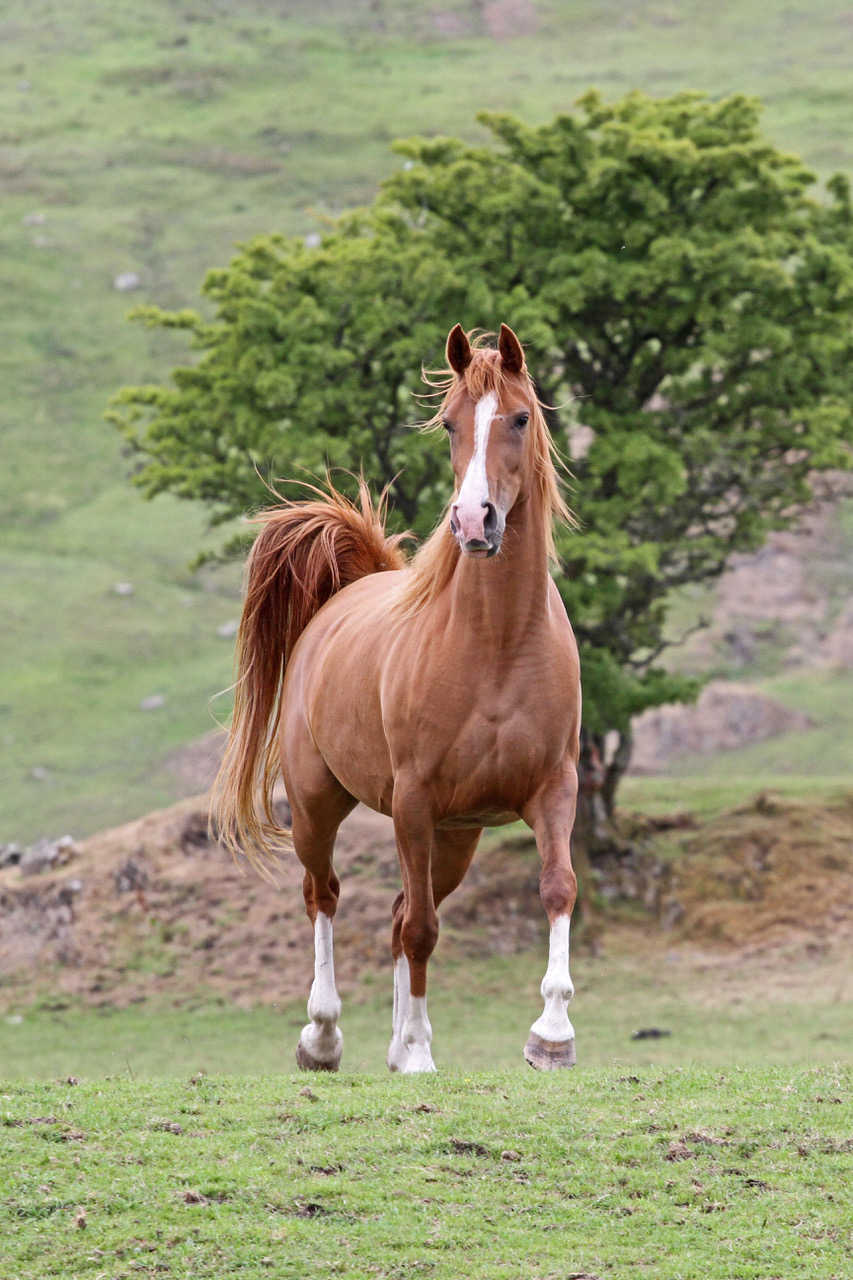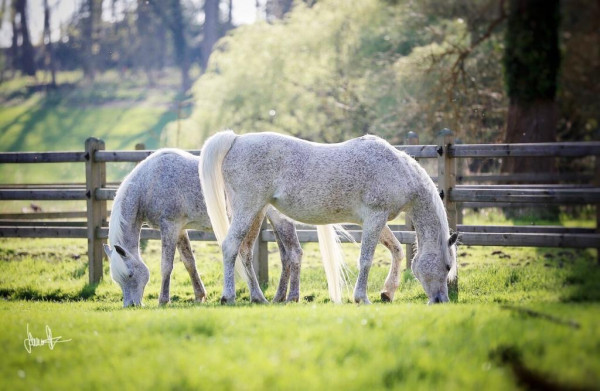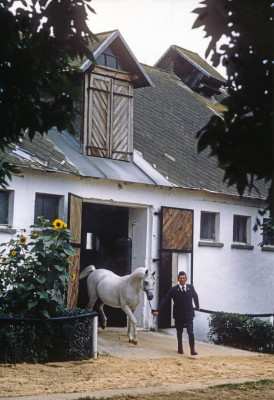An Enduring Passion
by Betty Finke
Do you remember what it was like?
The very first time you encountered an Arabian horse?
I’m betting the answer is "yes," because I certainly do. I remember it well, although it was a long time ago – over half a century, in fact. Though I didn’t know it then, that encounter was to change my life forever.
Let’s step back in time for a moment...
In the late 1960s/early 1970s, breeding Arabians was not an industry. It was a passion. A passion indulged by very few in my native Germany, where Arabians where still few and far between and shows were as yet unheard-of. I was a teen, and while other girls my age had their minds set on parties and boys, I was more interested in books and horses. Not Arabians, just horses in general. I had read The Black Stallion, of course, and I’d seen pictures of Arabians in books, so I know they existed. But they were rare in those days, and I’d never seen one. The only equine my family had ever owned was a grumpy pony named Peter, who sometimes grudgingly agreed to carry me on his back and more than once ditched me faster than you could say ‘oops’. Other than that, the only horses I knew first-hand were a warmblood gelding stabled across the road and a pair of magnificent black Oldenburg draft horses that pulled the local brewery cart.
It all changed when THE BOOK appeared: Arabians in Europe, by Erika Schiele. I have to write it in capitals, because it was that significant, not just for me. This book literally kick-started Arabian breeding in Germany. It introduced an entire generation of future breeders not only to the Arabian horse and its rich heritage, but to all the different types of Arabians bred in different European countries. Among them was a young woman called Sigi Siller who, inspired by this book, travelled to Spain and brought back a mare named Estopa. Need I say more? This book made history.
I devoured it of course, and I learned much in the process. For the first time, I read of Lady Anne and Wilfrid Blunt, and how they travelled to the desert to bring back the horses that became the foundation of Crabbet Park; of King Wilhelm I of Württemberg, who founded the Weil Stud in 1817, whose breeding program continues today at Marbach; of the war-torn, fractured history of Poland and its Arabian-breeding aristocrats. I learned how the stallions of Janow Podlaski, fleeing from the Russians, were caught in the bombing of Dresden in February 1945, and how Witraz and Wielki Szlem only survived because their groom Jan Ziniewicz hung on to them all through the inferno.
I also learned where the few Arabian studs in Germany were located. One of them was within easy reach and it happened to be part of a zoo, so anyone could go to see the horses along with the other animals. In fall 1971, the family took a day trip to the Ströhen Zoo, mostly an excuse for 16-year-old me to see the Arabians. I took along some apples from our orchard, to have something to give them.
That’s how I met Wiszkha and Inazzah, one of whom was born the same year I was and the other a year later, one of them a rich copper bay and the a other golden chestnut. The Book had taught me they were both bred by the Achental Stud, the first private post-war Arabian stud in Germany, founded with Arabians from Eastern Europe who had been stranded there after the War. One of those horses was Wisznu, the only *Witez II son born in Poland, and he was the sire of those two lovely ladies who graciously consented to accept my apples and to let me pet their soft, velvety muzzles. There was also a beautiful snow white mare who appeared to be above such mundane matters and kept her distance. Her name was Shari I and she was royalty, being from Marbach and thus descended from King Wilhelm’s horses, so she may be excused. These were the very first Arabians I met, and the first I photographed.



I returned there the next year with a bunch of photos of mares I couldn’t identify. The owner’s son, a certain Holger Ismer, was not only kind enough to sort out the horses for me, but gave me a booklet from Poland with all the Polish mare families and lots of historic photographs. Then he went and turned out the stallions for me, the ethereal and ultra-typey Shagar from Marbach and the newest arrival, the regal and gentle Negatiw son Diem from Poland. Shagar in particular rose to the occasion, flying up and down the fence of the mare pasture barely touching the ground, nostrils flared and tail held high. As it happened, he was a son of Ghazal, the stallion who had entranced Erika Schiele and inspired her to embark on her quest for Arabians across Europe and to write a book about it. And so it all came full circle, the process repeating itself in the next generation. Like Erika Schiele before me, I saw a fairy-tale white stallion dancing, and I fell in love.
I still am, or I wouldn’t be writing this. From that point on, my life revolved around Arabian horses. I looked for them wherever I went, I photographed each horse I saw, I studied their pedigrees, and eventually I started to write about them. The parallels were so striking that people at first confused me with Erika Schiele, or thought I was her pseudonym, and were very surprised when they actually met me. I eventually met Erika Schiele, too, but I think she was not amused, mostly because I was a lot younger than she was. We never became friends, but we respected each other. And we were united by the one thing that unites all of us: our mutual love and fascination for the Arabian horse.
For five decades, I have followed the trail of the Arabian horse across the world, recording what I saw in words and photographs. I was fortunate to discover the Arabian at the dawn of what is now referred to as the Golden Age, when new stud farms were established everywhere and the first international shows took place. I saw history in the making, meeting mares like Estopa and Hanan before they became icons of the breed. I missed Crabbet Park by a hair’s breadth, but I came to know British breeding while Crabbet bloodlines still ruled supreme and saw the slow changes brought by the steadily growing stream of imports. I walked through the pastures of Janow Podlaski and the stables of Michalow when Polish breeding was at its finest (and still Polish). Visiting places so steeped in the history of the breed is like a pilgrimage. So is visiting Marbach, with its 200-year-old breeding program, something I try to do on a regular basis.


These places have their own kind of magic. Walking through the gate and down the tree-lined path between the sand paddocks of El Zahraa in Cairo is the closest you can come to time tavel: it throws you right back into the days when breeders across the world lined up to buy Egyptian horses at the source. They no longer do, but the magic remains. And while the stud farms in the Middle East are all of modern origin, you still catch glimpses of the Arabian’s original homeland as you travel across the desert between oases and enjoy Arab hospitality in Bedouin tents.
The Arabian horse complete derailed my life (which was originally aimed towards becoming a teacher), but enriched it in more ways I can mention. It has taken me to places I would never have seen otherwise, from Poland and Russia to the deserts of Arizona, of Egypt, and of Kuwait, and brought me together with people I would never have known without it. Most of my friends today I would never have met, if the Arabian had not brought us together.
Over fifty years have passed since that first encounter. The world has changed, and so has the world of Arabian horses. What began as a small community of dedicated breeders following their dreams, has now become a global industry, complete with all the advantages and the disadvantages. An entire generation has grown up knowing Arabians mainly as ultra-refined show horses, clipped and made-up and posed in a way that makes them all look the same. Even the Polish state studs, once the last bastion of tradition, have succumbed to the lure of the mainstream and are losing everything that used to set them apart. No, not all changes have been for the better; some have been downright disastrous.
But some things don’t change. If you look beneath and beyond the glamour and glitter of the shows, you can still find the naturally beautiful, gentle, loving, and incomparably versatile creature the Arabian has always been. This horse needs no artificial enhancements to capture your heart. Just a field or a paddock, and he will dance and fly, a creature formed from the south wind of legend; he will prance and snort like a fire-breathing dragon, and the next moment he will come towards you and drop his warm muzzle into your hands, blowing out softly, asking you to rub his forehead or scratch his throat. This is the true Arabian horse; not the stylized model perfectly posed in the show ring. Yes, he can do that, too; but it’s not what he does best, not by a long shot. He is so much more than that.
And that is why, through all the change the past five decades wrought, the passion still burns for this most beautiful of equines, a breed that embodies history like no other. Apart from the mainstream, uncounted small and dedicated breeders all across the world still live that passion, doing all they can to preserve the rich heritage of the breed in all its facets.
So do I, though I am not a breeder. But I try to keep alive the flame, to preserve the heritage, by writing about it, so it is not forgotten. And once a year, I go back to that farm where I met the first Arabians that set me off on this incredible journey. Yes, it is still there. Each year I see, in that same paddock, the newest generation descended from the first horses I saw there. I also see, each year, a new lot of kids meeting their first Arabians, and perhaps catching that wonderful and incurable bug Erika Schiele called “Arabitis”. It is comforting to know that, in a rapidly changing and increasingly unstable world, the Arabian horse still endures. And as long as it does, it will keep inspiring and uniting people with an enduring passion that will change, and enrich, their lives forever.

























